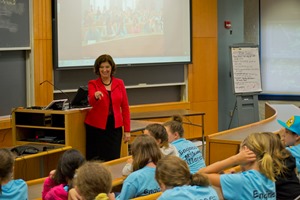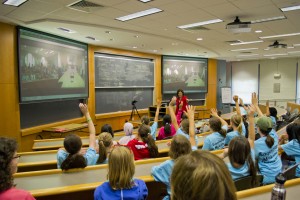A popular book title posits that men are from Mars, and women from Venus, but for more than a decade women have held key roles in the exploration of Mars. And with NASA’s Curiosity Mars rover having marked its first Martian year on the red planet (687 Earth days), NASA has been recognizing the contributions of the many women involved in the mission.
 That recognition continued on July 29 at WPI’s Camp Reach, when seventh-grade girls met with WPI President Laurie Leshin, and spoke with other women who continue to play important roles in NASA’s exploration of Mars, and in space exploration overall. During a presentation and question-and-answer session with the campers, Leshin described the Curiosity rover and the complexities faced by it and its controllers back on Earth. Leshin, a geochemist and space scientist, has been involved in the Curiosity project since its inception more than a decade ago, and she remains a team member today.
That recognition continued on July 29 at WPI’s Camp Reach, when seventh-grade girls met with WPI President Laurie Leshin, and spoke with other women who continue to play important roles in NASA’s exploration of Mars, and in space exploration overall. During a presentation and question-and-answer session with the campers, Leshin described the Curiosity rover and the complexities faced by it and its controllers back on Earth. Leshin, a geochemist and space scientist, has been involved in the Curiosity project since its inception more than a decade ago, and she remains a team member today.
In August 2012, after a nine-month voyage, Curiosity landed in Mars’ Gale Crater, where it has been analyzing soil and rocks, and looking for organic molecules. Controlling the rover is not done in real time, as it takes eight minutes for commands – traveling at the speed of light – to reach Mars, Leshin said. “We can’t talk to Curiosity the same way we could talk to something autonomous working here on Earth, where we could interact with it directly,” she told the girls. “We only talk to Curiosity twice a day.”
 The NASA women pointed out that work is now ongoing for Curiosity’s successor, which has not been given a formal name, but is referred to as “2020.” That rover will have some similarities to Curiosity, but new sampling system that will take core samples for later return to earth. It is hoped that samples eventually returned to Earth for analysis will help determine if there was past life on Mars.
The NASA women pointed out that work is now ongoing for Curiosity’s successor, which has not been given a formal name, but is referred to as “2020.” That rover will have some similarities to Curiosity, but new sampling system that will take core samples for later return to earth. It is hoped that samples eventually returned to Earth for analysis will help determine if there was past life on Mars.

